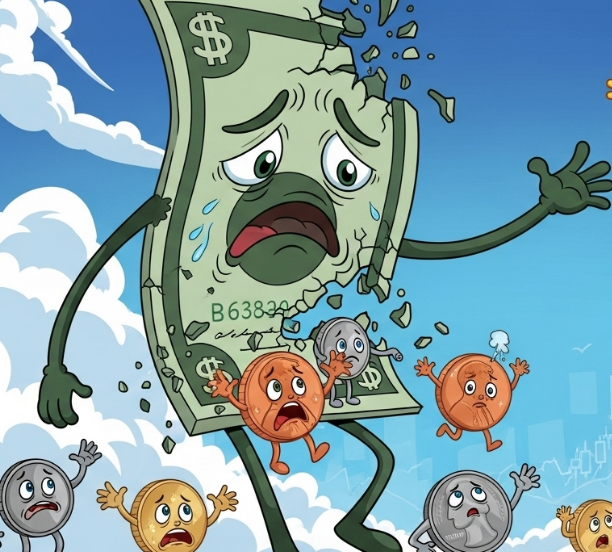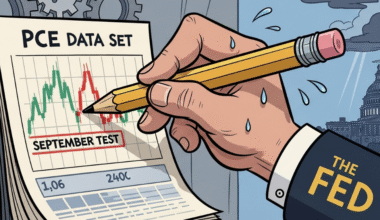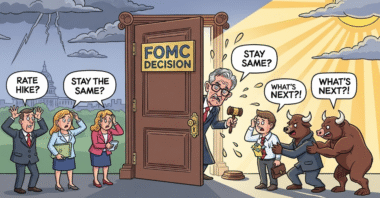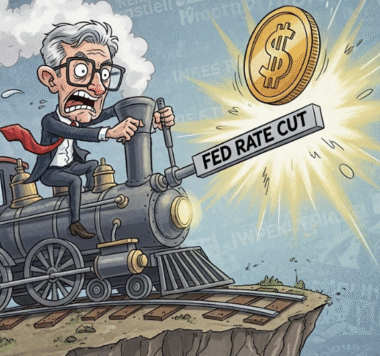You’re watching history unfold in real time. The U.S. Dollar Index has fallen 10.7% in the first half of 2025, marking its worst performance for this period in over 50 years. This isn’t just another market fluctuation. It’s a fundamental shift that’s creating a massive divergence within American equity markets—and the winners might surprise you.
Think of the dollar as the invisible hand that shapes every American company’s profitability. When that hand weakens, it doesn’t affect all stocks equally. Some companies see their earnings explode higher while others get crushed by rising costs. Right now, we’re watching this separation accelerate in real time.
The dollar index has fallen 10.8 percent in the first half of 2025, driven by multiple converging factors that aren’t going away anytime soon. President Trump’s stop-start tariff war, and his attacks that have led to worries over the independence of the Federal Reserve, have undermined the appeal of the dollar as a safe bet. Meanwhile, economists are worried about Trump’s “big, beautiful” tax bill, currently under debate in the US Congress, which is expected to add trillions of dollars to the US debt pile over the coming decade.
Why This Dollar Decline Is Different for Stocks
This isn’t your typical currency weakness. The gap between U.S. 10-year bond yields and those of major partners is at its widest since 1994. Foreign investors are quietly backing away from dollar assets. A recent Bank of America survey shows global fund managers at their lowest USD allocation since 2005.
For American equities, this creates a tale of two markets. Multinational corporations with significant overseas revenue are seeing those foreign earnings translate into more dollars when they report quarterly results. Meanwhile, domestic-focused companies are getting squeezed by higher import costs and reduced purchasing power.
The S&P 500’s performance masks this underlying story. While the index has posted gains, the real action is happening beneath the surface as investors rotate from domestic plays into international exposure stocks.
The Hidden Winners in Your Portfolio
A weakening dollar creates immediate tailwinds for a specific class of American companies that most investors overlook. These are the multinational giants that generate substantial revenue outside the United States. When the dollar weakens, their foreign earnings get a mathematical boost when converted back to dollars.
Technology companies with global reach are prime beneficiaries. Think Microsoft with its worldwide cloud infrastructure, Apple with its international iPhone sales, or Google with its global advertising revenue. Every euro, yen, or pound they earn translates into more dollars on their income statements.
The same dynamic benefits American manufacturing exporters. Companies like Boeing, Caterpillar, and General Electric see their products become more competitive internationally as dollar weakness makes American goods cheaper for foreign buyers. Export volumes typically surge during sustained dollar declines.
Consumer goods giants with international brands also benefit. Coca-Cola, McDonald’s, and Procter & Gamble all see their overseas earnings amplified by currency translation effects. These companies often see margin expansion during dollar weakness as their global revenue streams compound the benefits.
The Losers Nobody Wants to Talk About
While multinational companies celebrate, purely domestic American businesses face mounting pressure. Retailers that depend on imported goods see their cost structures deteriorate rapidly. Target, Walmart, and other retailers with significant import dependencies watch their margins compress as foreign suppliers demand more dollars for the same products.
Domestic-focused restaurants and service companies also struggle. Dollar weakness drives up commodity and energy costs, creating inflation pressures that squeeze companies unable to offset costs with international revenue. Regional banks face particular pressure as their loan portfolios become concentrated in domestic real estate and local businesses affected by rising import costs.
Small-cap stocks, which tend to be more domestically focused than large-caps, often underperform during sustained dollar weakness. The Russell 2000 typically lags the S&P 500 during these periods as international exposure becomes a competitive advantage.
The Fed’s Impossible Position
The Federal Reserve is caught between fighting inflation and supporting a weakening economy. Markets are now pricing in an 85% probability of a September rate cut, which would further pressure the dollar. Every rate cut makes American assets less attractive to foreign investors while potentially accelerating dollar weakness.
This creates a feedback loop for equities. Rate cuts typically boost stock valuations through lower discount rates, but dollar weakness can offset these gains for domestic companies while amplifying them for international revenue generators. The result is increasing divergence within American equity markets.
Technology stocks with global reach often benefit from both dynamics—lower rates boost their growth valuations while dollar weakness amplifies their international earnings. This explains why tech megacaps continue outperforming despite broader market uncertainty.
Your Stock Selection Strategy
The value proposition here isn’t about avoiding American equities—it’s about choosing the right American equities. Companies with significant international exposure are essentially providing you with built-in currency hedging while maintaining dollar-denominated ownership.
Look for companies that report substantial foreign revenue percentages. Many S&P 500 companies generate 40-60% of their revenue internationally. These firms benefit from dollar weakness while still giving you exposure to American innovation and management.
Energy companies present a particularly interesting case. As the dollar weakens, oil and gas prices often rise in dollar terms, benefiting American energy producers. Companies like ExxonMobil and Chevron not only benefit from higher commodity prices but also see their international operations become more profitable.
Healthcare and pharmaceutical companies with global drug sales also benefit. Pfizer, Johnson & Johnson, and Merck all have significant international revenue streams that get amplified during dollar weakness periods.
The Bigger Picture for American Markets
This isn’t just about individual stock picking. You’re witnessing a fundamental shift in how American companies compete globally. Dollar weakness makes American labor, manufacturing, and services more competitive internationally while making foreign goods more expensive domestically.
This creates long-term structural advantages for American companies that can capitalize on export opportunities while disadvantaging those dependent on imports. The winners in this environment are companies that can leverage America’s technological and innovative advantages while benefiting from improved cost competitiveness.
Manufacturing companies with domestic production facilities become more attractive as “reshoring” accelerates. Dollar weakness makes domestic production more cost-competitive relative to foreign alternatives, potentially driving a manufacturing renaissance in certain sectors.
The war in Ukraine accelerated de-dollarisation, as central banks worldwide witnessed Russia’s dollar reserves being effectively wiped out overnight. This trend, combined with America’s fiscal challenges, suggests dollar weakness may persist longer than typical cycles.
Positioning Your American Equity Portfolio
The smart approach isn’t abandoning American stocks—it’s tilting toward the right American stocks. Focus on multinational corporations with diversified revenue streams, strong international brands, and the ability to benefit from both dollar weakness and America’s competitive advantages.
Avoid or underweight purely domestic plays, import-dependent retailers, and companies with significant foreign cost structures but domestic revenue concentration. The currency translation effects will work against these businesses throughout this cycle.
Consider American companies with significant international operations as your hedge against further dollar weakness. These stocks provide upside exposure to currency movements while maintaining your investment in American innovation and market leadership.
The dollar’s 50-year dominance is ending, but American equity markets will adapt and evolve. The question isn’t whether to own American stocks, but which American stocks will thrive in this new monetary reality. Choose companies that benefit from dollar weakness rather than those that suffer from it, and you’ll position yourself ahead of the adjustment that’s already underway.








